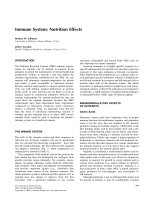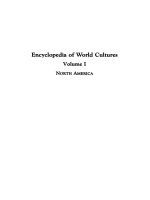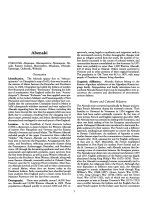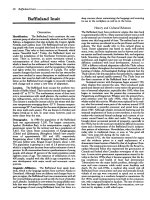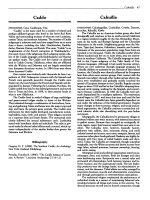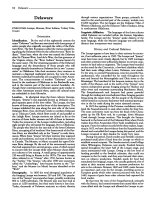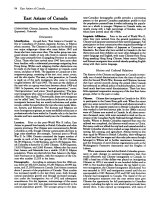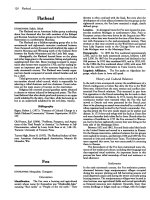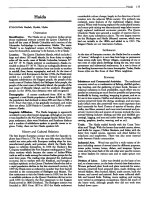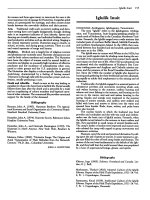Encyclopedia of World CulturesVolume I - NORTH AMERICA - F,G pdf
Bạn đang xem bản rút gọn của tài liệu. Xem và tải ngay bản đầy đủ của tài liệu tại đây (814.23 KB, 7 trang )
128
Flathead
Flathead
ETHNONYMS:
Salish,
Selish
The
Flathead
are
an
American
Indian
group
numbering
about
four
thousand
who
live
with
members
of
the
Kalispel
and
Kutenai
American
Indian
groups
on
the
Flathead
Indian
Reservation
in
northwestern
Montana.
The
Flathead
are
a
Salishan-speaking
group
who
in
the
seventeenth
and
eighteenth
centuries
numbered
between
three
thousand
and
six
thousand
and
inhabited
the
region
of
western
Montana
and
Wyoming
north
of
the
Gallatin
River
between
the
Rocky
Mountains
and
the
Little
Belt
range.
Aboriginally,
the
Flathead
hunted
bison
on
the
plains
and
other
large
game
in
the
mountains;
fishing
and
gathering
supplemented
their
diet.
Bison
hunting
increased
in
impor-
tance
after
horses
were
acquired
in
1700,
and
fur
trading
be-
came
an
important
part
of
the
economy
beginning
in
the
early
nineteenth
century.
The
Flathead
were
loosely
organ-
ized
into
bands
composed
of
several
related
families
and
led
by
a
chief.
Tribal
government
on
the
reservation
today
consists
of
a
ten-member
elected
tribal
council,
which
is
responsible
for
selecting
a
tribal
chairman
and
vice
chairman.
Forest
indus-
tries
are
the
main
source
of
income
on
the
reservation.
Religious
life
centered
around
guardian
spirits
obtained
in
dreams
or
visions
induced
by
fasting
and
prayer.
The
Flat-
head
believed that
after
death
good
souls
journey
to
an
upper
world
inhabited
by
the
deity,
Amo'tken,
while
bad
souls
go
to
live
in
an
underworld
inhabited
by
the
evil
deity,
Amte'p.
Bibliography
Bigart,
Robert
J.
(1971).
"Patterns
of
Cultural
Change
in
a
Salish
Flathead
Community."
Human
Organization
30:229-
237.
Old
Person,
Earl
(1984).
"Problems,
Prospects,
and
Aspira-
tions
of
the
'Real
People'
in
America."
In
Pathways
to
Self-
Determination,
edited
by
Leroy
Little
Bear
et
al.,
148-151.
Toronto:
University
of
Toronto
Press.
Turney-High,
Harry
H.
(1937).
The
Flathead
Indians
of
Mon-
tana.
American
Anthropological
Association,
Memoir
48.
Menasha,
Wis.
Fox
ETHNONYMS:
Mesquakie,
Outagami
Orientation
Identification.
The
Fox
were
a
hunting
and
agricultural
society
whose
name
for
themselves
was
'Meskwahli-haki,"
meaning
"Red
earths"
or
"People
of
the red
earth."
Their
identity
is
often
confused
with
the Sauk.
But
even
after
the
development
of
a
close
alliance
between
the
two
groups
in
the
eighteenth
century,
the
Fox
have
remained
a
single,
clearly
defined
group.
Location.
In
aboriginal
times
the
Fox
were
located
in
pres-
ent-day
southern
Michigan
or
northwestern
Ohio.
Prior
to
European
contact
they
were
driven
by
the
Iroquois
into
Wis-
consin,
where
they
were
located
at
the
time
of
first
direct
con-
tact
with
Europeans
in
the
mid-seventeenth
century.
Their
territory
at
that
time
centered
on
the
Wolf
River
and
spread
from
Lake
Superior
south
to
the
Chicago
River
and
from
Lake
Michigan
west
to
the
Mississippi
River.
Demography.
In
1650
the
Fox
numbered
approximately
2,500,
and
in
the
early
nineteenth
century,
between
1,600
and
2,000.
By
1867
the
Fox
population
had
declined
to
but
264
persons.
In
1932
they
numbered
403,
and
in
1955,
653.
In
the
1980s
the
Fox
numbered
about
1,000,
with
some
500
on
the
Sac
and
Fox
Reservation
in
Tama
County,
Iowa.
inguistic
Affiliation.
The
Fox
spoke
an
Algonkian
lan-
guage,
which
those
in
Iowa
still
speak.
History
and
Cultural
Relations
In
the
mid
to
late
seventeenth
century
the
establishment
of
a
French
trading
post
at
Green
Bay
drew
the
Fox
to
the
Wolf
River
area.
Almost
from
the
start,
tension
and
conflict
char-
acterized
Fox-French
relations.
This
stemmed
in
part
from
Fox
opposition
to
the
French
extending
the
fur
trade
to
their
traditional
enemies,
the
Dakota.
In
1712,
twenty-five
years
of
continuous
warfare
were
initiated
when
the
Fox
who
had
moved
to
Detroit
and
were
presumed
by
the
French
post
there
to
be
planning
an
assault
were
attacked
by
a
coalition
of
tribes
organized
and
incited
by
the
French
commander.
Dur-
ing
this
period
the
Fox
were
nearly
wiped
out
by
warfare
and
disease.
In
1733
they
took
refuge
with
the
Sauk
at
Green
Bay
and
soon
thereafter
both
tribes
fled
to
Iowa.
Shortly
after
the
cessation
of
hostilities
in
1737
the
Fox
returned
to
Wiscon-
sin,
but
by
the
late
eighteenth
century
they
were
living
on
the
Iowa
side
of
the
Mississippi
River.
Between
1832
and
1842,
Fox
and
Sauk
ceded
their
lands
to
the
United
States
and
moved
to
a
reservation
in
Kansas.
On
the
Kansas
reservation,
relations
between
the
two
groups
were
marked
by
tension,
and
between
1856
and
1859
the
Fox
returned
to
Iowa
and
settled
near
Tama.
The
federal
govern-
ment
opposed
this
move,
but
was
unsuccessful
in
returning
them
to
Kansas.
The
descendants
of
the
Fox
have
maintained
many
ele-
ments
of
the
traditional
culture,
including
their
language
and
clan-organized
ritual
activities.
An
important
factor
in
this
process
has
been
tribal
ownership
of
land
and
resistance
to
land
allotment.
Settlements
In
the
early
nineteenth
century,
the
Fox
settlement
pattern
alternated
between
large
semipermanent
villages
occupied
during
the
summer
planting
and
fall
harvesting
seasons
and
small
dispersed
camps
used
during
the
winter
and
early
spring
hunting
seasons.
The
semipermanent
villages
were
located
in
river
bottoms
near
agricultural
fields
and
moved
periodically
as
firewood
resources
were
depleted.
Generally,
fewer
than
twenty
dwellings
or
lodges
made
up
a
village,
with
the
lodges
Fox
129
aligned
in
parallel
rows
along
an
east-west
axis.
A
typical
summer
lodge
consisted
of
an
elm-bark-covered
pole
scaf-
folding
measuring
forty
to
sixty
feet
long
and
twenty
feet
wide.
Winter
camps
varied
in
size
from
one
to
a
few
extended
families,
with
dwellings
consisting
of
dome-shaped,
pole-
framed
structures
covered
with
cattail
mats.
On
the
3,476-
acre
reservation,
the
Fox
now
live
in
scattered
modem
housing.
Economy
Subsistence
and
Commercial
Activities.
The
Fox
were
hunter-farmers
whose
subsistence
focused
on
deer,
bison,
maize,
squash,
beans,
and
pumpkins.
Trapping
and
hunting
for
the
fur
trade
became
an
important
part
of
the
economic
pattern
very
soon
after
European
contact.
At
the
beginning
of
the
nineteenth
century
the
seasonal
pattern
of
economic
ac-
tivities
included
planting
crops
in
May
and
June
and
harvest-
ing
in
the
early
autumn,
after
which
the
summer
villages
dis-
persed
and
the
people
journeyed
to
their
hunting
grounds.
Hunts
were
also
carried
out
during
the
summer
growing
sea-
son.
Midwinter
was
spent
in
temporary
camps
in
sheltered
river
bottoms
where
the
people
remained
until
hunting
activi-
ties
were
renewed
in
the
early
spring.
In
April
the
dispersed
families
returned
to
their
summer
village
and
initiated
a
new
cycle
of
agricultural
activities.
Since
the
1950s,
commuting
to
work
in
nearby
cities
has
been
an
important
part
of
the
economic
pattern
of
Fox
living
near
Tama,
Iowa.
Tribal
income
is
derived
from
renting
tribal
lands
to
local
farmers.
Industrial
Arts.
The
Fox
displayed
a
typical
Woodland
pat-
tern,
relying
on
the
bow
and
arrow
for
hunting
and
warfare.
Clothes
were
made
from
deerskin.
Aboriginal
manufactures
were
quickly
replaced
with
items
obtained
from
Europeans.
Trade.
Apart
from
furs
taken
to
obtain
European
trade
goods,
hides
and
tallow,
a
by-product
of
deer
hunting,
and
lead
ore
obtained
through
surface
mining
were
important
trade
items
for
the
Fox
during
the
historic
period.
Division
of
Labor.
Traditionally
men
hunted,
and
women
were
responsible
for
growing
crops
and
gathering
roots,
nuts,
berries,
and
animal
by-products
such
as
honey
and
beeswax.
Land
Tenure.
When
they
settled
near
Tama,
Iowa,
in
1857,
the
Fox
purchased
80
acres
of
land;
since
that
time
ad-
ditional
land
purchases
have
brought
tribal
holdings
to
3,476
acres.
Kinship
Kin
Groups
and
Descent.
Fox
kin
groupings
consisted
of
numerous
exogamous
patrilineal
clans,
the
corporate
features
of
which
focused
on
ritual
activities
and
rights
to
clan
names.
In
theory,
each
clan
was
descended
from
a
vision
seeker
who
had
been
blessed
by
a
spirit.
Lineages
composing
the
clans
were
the
primary
means
for
the
inheritance
of
rights
to
ritual
positions
and
political
offices
and
also
served
to
regulate
sec-
ondary
marriages.
Descent
was
patrilineal.
Kinship
Terminology.
Kinship
terminology
followed
the
Omaha
system.
Marriage
and
Family
Marriage.
Marriage
within
one's
clan
was
forbidden.
Whether
arranged
by
the
couple,
a
go-between,
or
through
negotiations
between
families,
marriage
was
validated
by
an
exchange
of
gifts
between
families.
Polygyny
was
permitted;
however,
its
frequency
is
unclear.
After
marriage,
the
couple
resided
with
the
wife's
parents
for
one
year
or
until
the
birth
of
their
first
child;
thereafter
they
might
live
in
their
own
lodge
or
with
the
husband's
parents.
Widows
and
widowers
were
expected
to
replace
their
deceased
spouse with
a
mem-
ber
of
the
spouse's
lineage;
failure
to
do
so
brought
retribu-
tion
from
the
women
of
the
offended
lineage
in
the
form
of
the
destruction
of
the
offender's
property.
Domestic
Unit.
Each
household
consisted
of
an
extended
family
of
between
five
and
thirty
persons.
Each
extended
fam-
ily
constituted
an
economic
unit
whose
members
cooperated
in
hunting
and
agricultural
activities.
Inheritance.
Ritual
positions
and
political
offices
were
controlled
by
lineages
and
inherited
patrilineally.
Socialization.
Corporal
punishment
of
children
was
rare,
the
preferred
method
being
forced
fasting
to
instill
correct
be-
havior.
During
her
first
menstruation,
a
girl
was
isolated
in
a
separate
lodge
for
ten
days
as
a
precaution
against
endanger-
ing
others
and
herself;
during
subsequent
menstrual
periods
she
was
similarly
isolated
but
for
shorter
periods
of
time.
For
boys,
puberty
was
marked
by
a
vision
quest,
undertaken
in
isolation,
with
the
object
of
gaining
spiritual
power.
Girls
also
sought
visions,
but
not
in
isolation
nor
as
part
of
menstrual
seclusion.
Sociopolitical
Organization
Social
Organization.
Fox
society
was
split
into
two
divi-
sions
whose
lines
crosscut
clan
and
lineage
divisions.
The
two
divisions
were
represented
by
the
colors
white
and
black
and
organized
the
people
for
games,
ceremonies,
dances,
and
war-
fare.
The
firstborn
child
of
a
couple
was
assigned
to
the
divi-
sion
to
which
the
father
did
not
belong,
and
subsequent
chil-
dren
were
assigned
to
alternate
divisions
according
to
their
order
of
birth.
Numerous
permanent
and
temporary
volun-
tary
associations
existed
for
raiding,
ritual,
and
other
pur-
poses.
Political
Organization.
Politically,
Fox
society
was
di-
vided
into
peace
and
war
organizations,
each
with
its
own
chief
and
subordinate
officeholders.
The
peace
chief
had
lit-
tle
authority
and
functioned
primarily
as
a
moderator;
he
was
selected
for
the
position
from
a
specific
lineage
which
con-
trolled
rights
to
the
office
by
a
tribal
council.
During
times
of
war
and
other
threatening
periods,
the
war
chief
and
the
war
organization
held
considerable
power.
For
the
war
chief,
this
stemmed
from
his
control
over
the
camp
police,
an
organiza-
tion
of
warriors
that
enforced
decisions
made
by
the
tribal
council.
In
the
early
nineteenth
century,
the
war
chief
ac-
quired
office
through
successful
leadership
in
warfare.
At
an
earlier
time,
however,
clan
affiliation
may
have
been
an
im-
portant
factor
in
access
to
the
office.
Membership
in
the
tri-
bal
council
was
controlled
by
a
specific
lineage
and
its
respon-
sibilities
included
issues
such
as
peace
and
war,
relations
with
other
tribes,
and
the
selection
of
winter
hunting
grounds.
130
Fox.
Today,
an
elected
tribal
council
of
seven
members
meets
monthly
to
manage
tribal
affairs.
Social
Control
and
Conflict.
In
addition
to
enforcing
the
decisions
of
the
tribal
council,
the
camp
police
regulated
tri-
bal
movements
and
patrolled
the
campgrounds
during
bison
hunts.
Their
unquestioned
right
to
destroy
the
property
of
anyone
who
disobeyed
them
enabled
the
camp
police
to
func-
tion
effectively
as
a
mechanism
of
social
control.
Currently,
tension
exists
between
the
traditional
and
progressive
fac-
tions
who
disagree
about
the
extent
to
which
the
tribe
should
follow
White
economic
and
political
practices.
Religion
and
Expressive
Culture
Religious
Beliefs.
Fox
cosmology
included
a
belief
in
an
upper
world
in
the
sky,
associated
with
good,
and
a
lower
world
beneath
the
earth,
associated
with
evil.
The
Fox
be-
lieved
themselves
to
be
the
grandchildren
of
the
earth
and
all
that
grew
on
it.
Fox
supernatural
beings
included
Great
or
Gentle
Manitou,
who
ruled
the
upper
world.
Other
important
supernatural
beings
included
spirits
associated
with
the
four
cardinal
directions
and
the
earth.
Religious
Practitioners.
Certain
prescribed
actions
could
be
undertaken
to
gain
the
attention
and
favor
of
the
spirits
and
place
them
under
obligation.
These
actions
included
blackening
one's
face,
fasting,
wailing,
and
smoking
or
offer-
ing
tobacco,
which
was
believed
to
be
greatly
desired
by
the
spirits,
but
accessible
to
them
only
through
human
beings.
Successful
vision
questers
were
believed
to
be
able
to
draw
on
supernatural
powers
contained
in
sacred
packs
they
assem-
bled
following
their
vision
experience.
In
some
instances,
in-
dividuals
experienced
multiple
intense
visions;
the
sacred
packs
associated
with
these
visions
were
believed
to
be
ex-
tremely
powerful,
with
benefits
extending
to
the
clan
and
lineage
of
the
vision
quester.
Ceremonies.
Two
ceremonies
were
held
annually
in
order
to
maintain
the
powers
of
the
sacred
packs
of
clans
and
line-
ages.
One
of
these,
a
winter
ceremony,
was
small
and
lacked
elaborate
ritual
and
social
activities.
The
second,
held
in
the
summer,
was
rich
in
such
activities,
including
prayers,
songs,
the
telling
of
the
histories
of
the
sacred
packs,
dancing,
and
feasting.
Arts.
Body
ornamentation
was
important
to
the
Fox.
They
were
highly
skilled
in
ribbon
applique
and
silverwork
and
the
production
of
beaded
ornaments.
Medicine.
The
Fox
developed
a
rich
pharmacopoeia,
and
curers
used
over
two
hundred
plant
materials
in
curing,
most
of
which
were
used
for
intestinal
disorders.
Most
were
taken
internally,
some
applied
externally,
and
a
few
burned
for
the
therapeutic
value
of
the
smoke.
Death
and
Afterlife.
Death
was
announced
by
a
village
crier
and
followed
by
an
all-night
mourning
ceremony
at
the
deceased's
lodge
by
the
deceased's
clan
members.
The
corpse
was
dressed
in
the
finest
clothing
and
wrapped
in
bark
or
reed
mats
prior
to
burial.
Interment
was
usually-
in
the
ground,
with
the
corpse
extended
and
oriented
along
an
east-west
axis,
the
feet
to
the
west.
Noted
warriors
were
commonly
bur-
ied
in
a
seated
position.
The
burial
ceremony
included
an
ad-
dress
by
a
funeral
director
and
tobacco
offerings
by
the
direc-
tor
and
mourners;
the
earth-filled
grave
was
covered
over
by
a
small
wooden
shed
and
marked
with
a
post
at
the
head
that
indicated
the
deceased's
clan
affiliation.
Grave
goods
were
few,
and
the
deceased's
property
was
divided
by
burial
attend-
ants
and
the
deceased's
surviving
relatives.
Within
four
years
of
an
individual's
death,
an
adoption
ceremony
was
held
that
served
to
release
mourners
from
their
obligations
and
bring
into
the
deceased's
lineage
a
friend
or
other
person
chosen
by
the
surviving
relatives.
Usually
the
adoptee
was
a
person
of
the
same
sex
and
age
of
the
deceased,
and
the
ceremony
of
adoption
included
feasts,
games,
danc-
ing,
and
the
exchange
of
gifts.
Bibliography
Callender,
Charles
(1978).
"Fox."
In
Handbook
of
North
American
Indians.
Vol.
15,
Northeast,
edited
by
Bruce
G.
Trig-
ger,
636-647.
Washington,
D.C.:
Smithsonian
Institution.
Hagan,
William
T.
(1950).
The
Sac
and
Fox
Indians.
Norman:
University
of
Oklahoma
Press.
Jones,
William
(1939).
Ethnography
of
the
Fox
Indians.
U.S.
Bureau
of
American
Ethnology
Bulletin
no.
125.
Washing-
ton,
D.C.
GERALD
F.
REID
French
Canadians
ETHNONYMS:
Francophones
(outside
of
Quebec),
Quibecois
Orientation
Identification.
French
Canadian
is
a
generic
term
applied
to
all
descendants
of
French
settlers
in
Canada.
They
form
two
groups:
Quibecois
in
the
province
of
Quebec,
and
Fran-
cophones
outside
of
Quebec.
The
former
identify
themselves
as
a
distinct
society
and
culture.
The
latter
form
a
diaspora
having
a
minority
status,
namely,
Acadians
in
the
Maritime
Provinces
and
French
Canadian
communities
in
Ontario
and
the
western
provinces.
Location.
Quebec
Province
is
bounded
by
Hudson
Bay
and
Ontario
on
the
west,
New
Brunswick
on
the
east,
Labra-
dor
and
the
Arctic
Ocean
on
the
north,
and
New
York
on
the
south.
Its
area
is
1,540,680
square
kilometers.
Geographi-
cally,
the
St.
Lawrence
lowlands
separate
the
Canadian
Pla-
teau
from
the
Appalachians.
An
Arctic
climate,
vegetation,
and
fauna
are
found
in
the
north;
subarctic
climate
in
the
center,
and
continental
humid
with
mixed
forest
and
a
grow-
ing
season
of
60
to
160
days
in
the
south.
Demography.
The
total
population
is
about
6.4
million
persons
in
Quebec
and
500,000
outside
Quebec.
Franco-
phones
form
90
percent
and
Anglophones
10
percent
of
the
population
of
Quebec.
The
Francophone
population
is
now
French
Canadians
131
mainly
urban,
living
in
Montreal
and
Quebec
City
metropoli-
tan
areas.
The
remainder
of
the
population
of
Quebec
is
sparsely
distributed
in
regional
cities
of
less
than
10,000
per-
sons
and
in
rural
areas.
Francophones
outside
Quebec
live
in
small
localities
and
rural
areas,
but
some
have
migrated
re-
cently
to
cities.
inguistic
Affiliation.
French
has
been
the
official
lan-
guage
of
Quebec
Province
since
1974.
In
the
1970s
the
status
of
the
French
language
became
an
important
political
issue:
Quebec
governments
adopted
linguistic
laws.
In
other
prov-
inces,
French
Canadian
communities
must
struggle
to
have
their
own
institutions
in
order
to
preserve
their
language
and
culture
and
avoid
assimilation.
In
New
Brunswick
and
On-
tario
they
now
have
access
to
French-language
governmental
services,
education,
and
radio
and
television.
The
language
spoken
in
Quebec
differs
from
that
in
France
in
its
vocabulary
and
pronunciation.
The
Quebec
government
decided
in
1979
to
translate
English
technical
terms
and
promote
Frenchification
of
all
enterprises
in
Quebec
so
that
French
would
be
predominant.
A
special
effort
was
also
made
to
in-
troduce
immigrants
to
the
language
in
order
to
protect
the
French
character
of
the
province.
History
and
Cultural
Relations
In
1534,
a
French
navigator
took
possession
of
the
eastern
part
of
Quebec
in
the
name
of
France.
Because
of
France's
in-
volvement
in
wars,
it
was
not
until
1608
that
Samuel
de
Champlain,
following
the
St.
Lawrence
River,
founded
Que-
bec
City,
the
first
settlement
of
the
colony
named
New
France.
From
1608
to
1760,
only
ten
thousand
persons
mi-
grated
from
France
to
the
colony,
and
present-day
French
Canadians
are
almost
all
descended
from
these
first
settlers.
New
France
differed
from
New
England
in
significant
ways.
France
was
a
feudal
society,
which
transplanted
the
seigneu-
rial
system,
French
law,
and
the
Roman
Catholic
church
to
New
France.
The
territory
was
divided
between
seigneuries
headed
by
a
seignor
collecting
seigneurial
dues
for
granting
land
to
censitaires,
or
peasant
setters.
The
New
France
econ-
omy
rested
on
subsistence
agriculture
and
the
fur
trade,
all
furs
being
exported
to
France.
The
territory
was
then
much
larger
than
now,
covering
the
Maritime
Provinces,
the
Great
Lakes
region,
the
central
part
of
the
United
States
along
the
Mississippi
River,
and
Louisiana.
In 1760,
New
France
became
an
English
colony.
Since
French
Canadians
formed
a
distinct
society
and
culture,
they
resisted
assimilation,
and
in
1774
the
English
compromised,
with
the
Act
of
Quebec
recognizing
French
Canadian
dis-
tinctiveness
and
affording
them
the
right
to
live
by
theirlaws,
religion,
and
language.
From
1774
to
1854,
the
seigneurial
system
and
the
Catholic
church
dominated
the
social
and
economic
life
of
French
Canadians.
The
church
allied
itself
with
the
seignors
and
English
rulers.
This
situation
was
re-
sented
by
the
professional
and
merchant
class,
leading
to
the
1837-1838
revolt,
which
was
put
down
by
the
English
army.
The
leaders
were
killed
or
jailed
and
the
peasant
population
demoralized
and
subordinated
to
the
Catholic
church.
From
1840
to
1867
the
colony
had
two
governments:
Upper
Can-
ada
with
Anglophone
settlers,
and
Lower
Canada,
the
French
Canadian
territory.
Each
had
its
own
somewhat
au-
tonomous
parliament
to
manage
its
internal
affairs.
In
1867,
a
federation
of
five
provinces
was
founded.
Lower
Canada
then
became
the
province
of
Quebec.
From
1867
to
1949,
five
other
provinces
joined
Canada.
In
the
federation,
Que-
bec
Province
maintained
its
cultural
distinctiveness.
A
strong
nationalist
movement
seeking
more
political
autonomy
for
Quebec
has
developed
since
1945.
The
Dup-
lessis
government
(1945-1959)
obtained
its
own
provincial
taxation
system.
In
1960,
a
Liberal
party
government
decided
to
modernize
the
economic,
educational,
and
health
systems,
marking
the
end
of
the
social
and
political
power
of
the
Cath-
olic
church
and
the
beginning
of
a
secular
society
in
which
the
state
plays
the
dominant
role.
Nationalist
aspirations
reached
their
high
point
in
the
1970s.
The
Parti
Quibecois
was
elected
in
1976
on
a
nationalist
platform.
It
lost
a
refe.
rendum
to
negotiate
the
independence
of
Quebec
in
1980
but
remained
in
power
until
1984.
In
1982,
the
province
was
excluded
from
the
new
constitution
of
Canada.
The
Liberal
party
government
was
elected
in
1984
with
the
mission
to
reintegrate
Quebec
into
the
Constitutional
Act.
Isolated
for
one
hundred
years
from
France,
franco-
quibecois
cultural,
economic,
and
political
relations
have
ex-
isted
since
the
1960s
and
have
been
extended
to
all
Franco-
phone
countries
in
Europe
and
elsewhere
through
the
regular
participation
by
the
Quebec
government
in
the
Francophone
Summit
for
the
past
twenty
years.
Quibecois
have
been
influ-
enced
almost
equally
by
France
and
the
United
States,
and
their
intellectual
and
organizational
life
is
a
synthesis
of
the
two.
Relations
with
English
Canada
have
been
more
limited
because
of
cultural
and
linguistic
differences
but
also
because
of
strained
relations.
Settlements
Two
settlement
patterns
have
shaped
the
Quebec
landscape.
Since
the
St.
Lawrence
River
and
its
tributaries
were
once
the
only
means
of
transportation,
all
farms
fronted
the
river
in
a
pattern
called
rangs.
Social
life
took
place
in
these
rangs
and
small
villages.
Settlements
spread
from
the
river
to
interior
lands.
From
1608
to
1850,
the
French
Canadians
lived
in
the
rangs
of
seigneuries
on
each
shore
of
the
St.
Lawrence
River
between
Quebec
and
Montreal.
In
the
1840s,
Scottish
and
Irish
settlers
colonized
the
eastern
townships
outside
the
seig-
neuries
according
to
the
English
pattern.
In
the
1860s,
pe-
riphetal
regions
of
Quebec
were
colonized
from
the
seigneu-
ries.
During
this
same
period,
thousands
of
French
Canadi-
ans
migrated
to
work
in
New
England
factories
where
they
formed
the
Franco-American
diaspora
Economy
Subsistence
and
Commercial
Activities.
Quebec
has
been
industrialized
since
the
1920s.
Before
1939,
more
than
20
percent
of
the
population
worked
in
agriculture,
industry
being
mostly
textile-
and
local-market-oriented.
World
War
II
accelerated
industrialization.
Today,
Quebec
is
an
industri-
ally
advanced
society.
Since
1960,
Quebec
governments
have
encouraged
a
diversified
industrial
base
of
Quibecois-owned
enterprises
through
a
social-democratic
policy
(social
assist-
ance,
free
health
services,
Health
and
Security
Commission)
and
an
interventionist
economic
policy
(statist
financial
in-
stitutions;
direct
subventions
to
industries;
nationalization
of
electricity,
automobile
insurance,
and
asbestos
companies;
construction
of
dams).
Agriculture
has
been
modernized
and
only
2
percent
of
the
population
is
now
engaged
in
farm
work.
132
French
Canadians
The
main
products
are
milk,
pork,
beef,
fruits,
and
vegetables,
grains,
and
greenhouse
crops.
Forests
have
attracted
pulp
and
paper
companies.
Industrial
Arts.
French
Canadians
make
traditional
and
modem
crafts.
The
traditional
crafts
focus
on
re-creations
of
folk
objects.
The
modem
is
creative
and
functional.
Craft-
work
is
taught
in
technical
schools
and
organized
in
associa-
tions
holding
annual
expositions.
Trade.
Cities
and
suburbs
have
shopping
centers
and
American-style
stores.
There
are
also
open-air
markets
during
the
summer
for
fruits
and
vegetables,
but
most
people
buy
their
food
in
supermarket
chains.
A
recent
trend,
however,
is
to
buy
fruits,
vegetables,
and
meat
directly
from
the
farm.
Division
of
Labor.
Traditionally,
women
working
on
the
farm
performed
a
great
variety
of
tasks.
Many
handled
all
the
farm
responsibilities
while
their
husbands
lumbered
in
the
forests
for
months.
They
also
received
more
education
than
men
and
managed
the
family
money.
Outside
of
agriculture,
they
could
work
only
as
teachers,
nurses,
or
industrial
work-
ers.
This
rigid
division
of
labor
was
challenged
by
a
strong
feminist
movement
during
the
1970s.
Since
1975,
steps
have
been
taken
to
give
women
equal
access
to
university
educa-
tion,
professions,
and
traditionally
male
jobs.
The
Quebec
government
has
followed
affirmative
action
guidelines
for
women
since
1981,
and
the
feminist
movement
has
been
in-
stitutionalized
through
the
formation
of
a
Consultative
Council
on
the
status
of
women
in
1977,
and
a
Feminine
Condition
Ministry
in
1979.
Important
changes
have
re-
sulted
in
the
division
of
labor
between
the
sexes
in
the
work-
place
and
in
the
family,
with
the
younger
generation
now
tak-
ing
sexual
equality
for
granted.
Land
Tenure.
Quebec
is
a
capitalist
society.
Private
own-
ership
is
the
rule
for
agricultural,
industrial,
and
commercial
property.
Family
farms
are
predominant
with
a
single
farm
owner
or
a
partnership
between
spouses
or
among
relatives.
Kinship,
Marriage
and
Family
Kinship.
French
Canadians
reckon
descent
bilaterally.
Kinship
terminology
distinguishes
the
paternal
from
the
ma-
ternal
line
by
adding
the
term
paternel
and
maternel
to
terms
like
uncle,
aunt,
or
cousin.
First,
second,
and
third
cousins
are
recognized.
Genealogical
knowledge
is
an
important
so-
cial
asset
in
which
women
excel.
In
rural
areas,
women
can
easily
state
every
kinship
tie
they
have
with
hundreds
of
per-
sons
for
five
or
six
generations.
Residence
was
traditionally
patrilocal
for
the
son
inheriting
the
paternal
farm
but
neo-
local
for
other
sons
and
daughters.
Now
it
is
neolocal
for
all.
Marriage.
Traditionally,
men
and
women
had
to
either
marry
or
remain
celibate,
taking
care
of
their
elderly
parents
or
entering
religious
communities.
Marriage
was
religious
and
divorce
prohibited
by
the
church.
Sexuality
was
severely
re-
pressed
and
only
allowed
as
a
means
to
produce
children.
Married
couples
felt
obligated
to
have
a
great
number
of
chil-
dren
to
ensure
the
survival
of
the
French
Canadian
nation.
A
radical
change
has
taken
place
since
1960,
with
fewer
men
and
women
entering
religious
communities
and
civil
mar-
riage,
birth
control,
and
divorce
now
the
norm.
The
typical
family
now
has
only
two
children,
and
50
percent
of
new
mar-
riages
end
in
divorce.
Sexuality
has
been
liberalized,
and
a
woman's
economic
status
in
marriage
has
been
recognized
by
civil
law
in
marriage
contracts
and
in
divorce
settlements.
Domestic
Unit.
Famille-souche,
consisting
of
a
married
couple,
their
numerous
children,
grandparents,
and
unmar-
ried
brothers
or
sisters
on
the
paternal
farm,
was
the
tradi-
tional
pattern.
For
sons
and
daughters
leaving
the
famille-
souche,
the
nuclear
family
was
the
rule.
The
nuclear
family
with
five
persons
or
less
is
now
prevalent,
with
a
growing
pro-
portion
of
single-parent
families
as
a
consequence
of
the
large
number
of
divorces.
Agricultural
families
have
followed
the
urban
pattern.
Inheritance.
Patrilineal
land
transmission
was
the
rule,
with
only
one
son
(usually
one
of
the
younger
ones)
inherit-
ing
the
paternal
farm,
the
other
sons
having
been
given
land
earlier
by
their
father.
Women
were
not
allowed
to
inherit
land,
though
they
now
can.
For
inheritance
of
other
goods,
English
practices
have
been
followed
since
the
nineteenth
century.
Socialization.
Traditionally,
children
in
rural
areas
re-
ceived
only
a
minimal
formal
education
for
three
to
six
years.
They
worked
on
the
farm
from
the
age
of
twelve
to
the
time
of
their
marriage.
Emphasis
was
placed
on
capacity
to
work
hard
and
on
respect
for
adults
and
church
authority.
Only
a
minor-
ity
had
an
opportunity
to
attend
the
colleges
and
universities
controlled
by
the
clergy.
Since
1960,
religious
educational
in-
stitutions
have
been
nationalized,
and
universal
access
to
for-
mal
education
has
been
promoted.
Familial
education
is
more
liberal
and
permissive
since
families
are
now
smaller.
With
the
changing
roles
of
men
and
women,
a
greater
empha-
sis
has
been
put
on
the
socialization
of
boys
and
girls
free
of
sexual
stereotypes
in
families
and
at
school.
Sociopolitical
Organization
Social
Organization.
The
class
structure
of
modem
Que-
bec
is
complex
and
consists
of
several
strata:
(1)
an
Anglo-
phone
bourgeoisie;
(2)
a
French
Canadian
middle
bourgeoi-
sie
having
interests
in
financial
institutions,
middle-sized
industries,
and
controlling
statist
economic
institutions,
which
supports
the
federalist
political
position
with
minimal
nationalist
claims;
and
(3)
a
petty
bourgeoisie
including
public-sector
managers
and
employees,
professionals,
and
small
entrepreneurs
in
industry
and
commerce,
which
sup-
ports
the
nationalist
party.
The
working
class
is
numerically
important
and
is
divided
into
two
groups:
workers
organized
in
strong
assertive
unions
that
have
won
acceptable
salaries
and
working
conditions,
and
poorly
paid
nonunionized
work-
ers.
In
agriculture,
family
farms
are
the
majority.
Farmers
are
organized
and
control
the
sale
of
agricultural
products
through
quotas.
Quebec
has
more
unemployed
persons
than
other
provinces;
almost
15
percent
of
the
population
collects
unemployment
insurance
or
social
security
payments.
Political
Organization.
Quebec
is
a
province
with
its
own
parliament
within
a
federation.
According
to
the
Canadian
Constitution,
the
provincial
parliament
has
jurisdiction
over
educational,
health,
agricultural,
economic,
and
social
policy
in
the
province.
Quebec
governments
have
sought
additional
autonomy
from
the
federal
government
since
the
1940s.
The
political
system
is
bipartisan
with
two
major
political
parties
and
a
third
and
fourth
of
marginal
influence.
The
dominant
political
party
has
been
the
Liberal
party
(1960-1976;
1984-
French
Canadians
133
1990).
A
conservative
party
in
power
in
the
1950s
disap-
peared
in
the
1970s,
replaced
by
the
Parti
Quebecois,
which
governed
from
1976
to
1984.
The
Quebec
government
makes
decisions
concerning
education,
health,
and
economic
matters.
Municipalities
have
power
over
local
matters.
All
decisions
regarding
zoning,
the
environment,
transportation,
and
economic
development
are
centralized
at
the
government
level.
Municipalities
receive
a
part
of
their
budget
from
the
central
government
and
are
grouped
into
regional
units
to
coordinate
decision
making.
Deputies
are
important
intermediaries
between
the
people
and
the
government.
Ministries
have
delegated
some
of
their
power
to
semi-autonomous
commissions
like
the
Health
and
Security
Commission,
the
Right
of
Persons
Commission,
the
Agricultural
Markets
and
Agricultural
Credit
Commission,
the
French
Language
Commission,
and
the
Zoning
Com-
mission.
Social
Control.
Quebec
operates
under
two
legal
systems:
French
civil
law
and
English
criminal
law.
The
provincial
court
system
has
three
levels:
the
Ordinary
Court,
the
Provin-
cial
Court,
and
the
Superior
Court. Since
1981,
a
provincial
Charter
of
Person's
Right
predominates
over
all
laws.
Quebec
citizens
can
obtain
a
Supreme
Federal
Court
judgment
when
they
have
passed
through
the
three
levels
of
provincial
courts.
A
national
police
corps
has
jurisdiction
over
all
of
Quebec.
Conflict.
Armed
conflict
has
been
rare
in
Quebec
history
with
the
exception
of
the
1837
revolt.
In
1970,
when
a
terror-
ist
group
kidnapped
two
politicians,
war
powers
were
enacted
by
the
federal
government,
leading
to
the
arrest
of
hundreds
of
persons
and
the
military
occupation
of
Quebec.
The
main
conflicts
in
Quebec
are
not
ethnic,
but
protracted
conflicts
involving
unions
are
a
consequence
of
the
unions'
aggressive-
ness
in
defending
their
interests.
Racism
and
any
kind
of
dis-
crimination
are
overtly
condemned
and
they
occur
only
rarely.
Quibecois
are
on
the
whole
tolerant
and
pacific
peo-
ple
who
will
fight
for
respect
but
who
generally
live
in
peace
with
other
groups.
Religion
and
Expressive
Culture
Religious
Beliefs.
The
Catholic
religion
occupied
a cen-
tral
place
in
French
Canadian
life
from
the
beginnings
of
New
France
until
1960.
The
authority
of
the
Catholic
church
was
not
only
religious
but
also
social
through
the
religious
community's
monopolization
of
educational
and
health
insti-
tutions;
economic
through
the
wealth
of
the
clergy;
political
through
the
partisan
position
and
alliance
of
the
clergy
with
English
rulers
and
seignors
in
the
nineteenth
century
and
with
the
conservative
federal
and
provincial
governments
in
the
1940s
and
1950s;
and
ideological
because
of
the
church's
strong
opposition
to
liberal
and
democratic
ideas,
helping
those
with
conservative
and
elitist
ideas
to
remain
in
control.
With
the
Quiet
Revolution
in
the
1960s,
the
Catholic
church
lost
its
social
and
political
influence.
Quebecois
abandoned
religious
practices
and
beliefs
en
masse
and
rapidly
accepted
a
pluralistic
value
system.
But
schools
remained
confessional,
and
the
governments
have
lost
the
battle
for
the
complete
secularization
of
the
school
system.
Arts.
Quebecois
culture
has
been
flourishing
during
the
last
thirty
years
in
literature,
poetry,
popular
songs,
theater,
cinema,
painting,
sculpture,
and
music.
The
Quebec
govern-
ment
encourages
arts
with
subsidies
and
aid
for
travel
abroad.
Cultural
relations
with
France
have
helped
artists
to
become
known
in
Europe
and
to
build
an
international
reputation.
Quebec
culture
is
now
celebrated
internationally
for
its
diver-
sity
and
creativity.
Canadian
Francophones
outside
Quebec
followed
the
same
path.
Acadians
have
developed
their
own
literature,
theater,
and
popular
song,
as
is
the
case
with
Franco-Ontarians
and
Franco-Manitobans.
Medicine.
The
Quebec
health
system
was
nationalized
in
1960,
and
in
1969
the
Health
Insurance
Commission
was
created
by
law
to
provide
free
health
services
for
the
people.
Physicians
are
paid
for
their
services
by
the
commission.
With
the
aging
of
the
population,
a
debate
has
now
begun
because
the
costs
are
constantly
increasing.
Alternative
medical
prac-
tices
are
developing,
but
most
are
still
illegal.
Death
and
Afterlife.
Traditionally,
the
deceased
was
dis-
played
at
home
or
later
in
funeral
homes
for
two
days
for
viewing
by
kin
and
friends.
A
religious
funeral
ceremony
was
performed
on
the
third
day
and
a
banquet
organized
after
the
ceremony.
Catholic
funerals
have
been
the
norm
for
many
years.
Recently,
cremation
was
introduced
as
an
alternative
with
the
religious
ceremony
retained.
Beliefs
regarding
life
after
death
followed
the
teachings
of
the
Catholic
church,
which
insisted
in
the
1960s
that
those
who
did
not
conform
were
condemned
to
eternal
fire.
This
view
was
rejected
as
a
manipulative
attempt
by
the
church
to
maintain
its
waning
power.
See
also
Acadians
Bibliography
Anthropologie
et
soci&t&s.
Quebec:
Presses
de
l'Universit6
Laval.
Hamilton,
Roberta
(1988).
Feudal
Society
and
Colonization:
The
Historiography
of
New
France.
Gananoque,
Ontario:
Langdale
Press.
Moniere,
Denis
(1981).
Ideologies
in
Quebec:
The
Historical
Development.
Translated
by
Richard
Howard.
Toronto:
Uni-
versity
of
Toronto
Press.
Recherches
sociographiques.
Quebec:
Presses
de
l'Universit6
Laval.
Revue
d'histoire
de
l'Amerique
francaise.
Montreal:
Institut
de
l'Amerique
francais.
Ryan,
William
F.
(1966).
The
Clergy
and
the
Economic
Growth
of
Quebec,
1896-1914.
Quebec:
Presses
de
l'Univer-
site
Laval.
Sociologie
et
soci&t&s.
Montreal:
Presses
de
l'Universit6
de
Montreal.
Wade,
Mason
(1968).
The
French
Canadians,
1760-1967.
2
vols.
Toronto:
Macmillan.
LISE
PILON
134
Gosiute
Gosiute
The
Gosiute
(Goshute)
live
in
the
area
around
the
Great
Salt
Lake
and
to
the
west
in
Utah
and
Nevada.
They
speak
a
Sho-
shonean
language.
About
450
of
them
now
survive
in
Utah
and
Nevada
on
the
Goshute
and
Skull
Valley
Indian
Reserva-
tions
and
in
nearby
communities.
See
Western
Shoshone
Bibliography
Thomas,
David
Hurst,
Lorann
S.
A.
Pendleton,
and
Stephen
C.
Cappanari
(1986).
'Western
Shoshone."
In
Handbook
of
North
American
Indians.
Vol.
11,
Great
Basin,
edited
by
War-
ren
L
d'Azevedo,
262-283.
Washington,
D.C.:
Smithsonian
Institution.
Gros
Ventre
ETHNONYmS:
Atsina,
Fall
Indians,
Gros
Ventre
of
the
Prairie,
Hitunena,
Minnetarees
of
Fort
de
Prairie,
Rapid
Indi-
ans,
White
Clay
People
The
Gros
Ventre
(Aaninena,
Haaninin)
are
an
Algon-
kian-speaking
American
Indian
group
closely
related
to
the
Arapaho.
In
the
eighteenth
century
they
lived
on
the
Cana-
dian
plains
in
the
forks
of
the
Saskatchewan
River
region.
Late
in
the
century,
weakened
by
the
smallpox
epidemic
of
1780,
they
moved
south
to
the
Milk
River
region
in
north-
central
Montana
and
have
remained
there
ever
since.
From
1818
to
1823
some
moved
further
south
and
lived
with
the
Arapaho,
but
later
rejoined
the
group.
Their
long
alliance
with
the
Blackfoot
effectively
ended
when
they
aligned
them-
selves
with
the
Crow,
and
both
groups
were
defeated
by
the
Blackfoot
in
1867.
The
U.S.
government
established
the
Fort
Belknap
Res-
ervation
for
them
and
the
Assiniboin
in
Montana
Territory
in
1888,
and
they
have
mostly
remained
on
the
reservation
since
then.
Estimates
place
the
1950
Gros
Ventre
reservation
pop-
ulation
at
1,100
and
the
combined
Gros
Ventre-Assiniboin
population
at
1,870
in
1980.
On
the
reservation,
the
Fort
Belknap
Community
Council
is
the
governing
body.
It
has
twelve
members
from
four
districts
with
the
Gros
Ventre
and
Assiniboin
having
equal
representation.
Tribal
income
de-
rives
mainly
from
land
leases.
There
are
some
small
Indian-
owned
stores
and
a
tribally
owned
utility
commission.
There
are
large
deposits
of
gravel,
bentonite,
gas,
and
oil
on
the
res-
ervation,
with
only
gravel
extracted
and
sold.
The
Labor
Day
Celebration
and
the
Mid-Winter
Fair
are
the
two
major
reser-
vationwide
festivals.
Aboriginally,
the
Gros
Ventre
were
divided
into
twelve
autonomous
bands.
Each
band
was
led
by
a
chief
who
usually
made
decisions
in
consultation
with
other
male
members
of
the
band.
Each
band
also
had
other
chiefs,
afforded
that
sta-
tus
because
of
their
prowess
in
war.
In
winter,
the
bands
camped
separately,
usually
in
wooded
areas
along
waterways
as
protection
from
the
harsh
weather.
In
the
warmer
months
they
coalesced
for
the
spring
and
fall
bison
hunts,
and
for
var-
ious
ceremonies,
including
the
Sun
Dance.
At
these
times,
they
camped
in
a
circle,
with
an
opening
facing
to
the
east,
and
with
each
band
having
its
own
place
in
the
circle.
Sub-
sistence
was
based
on
the
bison,
every
part
of
the
animal
being
used
in
some
way-the
meat
was
roasted,
boiled,
or
dried,
the
hides
used
for
clothing,
tipi
covers,
and
trade
with
Whites.
The
tipi
covers
could
also
be
converted
into
round
boats
for
crossing
large
rivers.
Deer,
elk,
and
antelope
were
also
hunted,
and
berries,
fruits,
and
roots
were
collected
by
women.
There
was
once
a
tradition
of
pottery
making,
but
al-
most
none
has
been
made
in
the
last
two
centuries.
Men
en-
gaged
in
hunting
and
warfare,
while
women
did
most
of
the
work
around
the
camp.
All
girls
were
given
in
marriage
before
puberty
to
older
men,
but
men
usually
delayed
marriage
until
they
were
twenty
years
old.
Polygyny
was
common,
as
was
divorce,
which
was
usually
initiated
by
the
husband.
Most
women
married
three
or
four
times
during
their
lifetime.
The
sororate
and
levirate
were
customary.
Each
child
belonged
to
the
band
of
his
or
her
father.
There
was
strict
mother-in-law
avoidance,
with
moth-
er-in-law
and
son-in-law
forbidden
to
speak,
look,
or
be
in
the
same
tipi
with
each
other.
Father-in-law
avoidance
was
less
restrictive.
At
adolescence,
boys
entered
one
of
the
age-
graded
societies
and
also
became
a
member
of
either
the
Star
Society
or
the
Wolf
Society,
each
of
which
had
peacekeeping
and
social
functions.
At
death,
the
individual
had
a
scaffold
burial,
in
a
tree
or
in
a
cave,
with
some
personal
possessions.
The
Flat
Pipe
and
Feathered
Pipe
Rites
were
important
cere-
monies,
with
personal
supernatural
powers
and
visions
also
significant.
Today,
the
Gros
Ventre
are
predominatly
Roman
Catholic.
Bibliography
Cooper,
John
M.
(1956).
The
Gros
Ventre
of
Montana.
Pt.
2,
Religion
and
Ritual.
Catholic
University
of
America,
Anthro-
pological
Series,
no.
16.
Washington,
D.C.
Flannery,
Regina
(1953).
The
Gros
Ventre
of
Montana.
Pt.
1,
Social
Life.
Catholic
University
of
America,
Anthropological
Series,
no.
15.
Washington,
D.C.
Fowler,
Loretta
(1987).
Shared
Symbols,
Contested
Meanings:
Gros
Ventre
Culture
and
History.
Ithaca,
N.Y.:
Cornell
Uni-
versity
Press.
Kroeber,
Alfred
L.
(1907).
Ethnology
of
the
Gros
Ventre.
American
Museum
of
Natural
History,
Anthropological
Pa-
pers
1,
145-281.
New
York.
